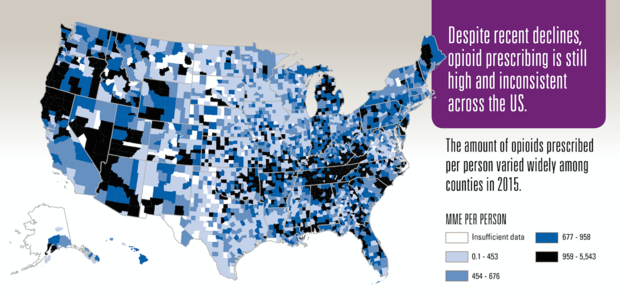Opioid prescriptions drop, but some U.S. counties prescribe far more than others
The United States has seen a decrease in the amount of opioids prescribed in recent years, but usage is still high, and certain counties are dispensing the powerful painkillers at much higher rates than others, according to a new government report.
The data published by the Centers for Disease Control and Prevention found that in 2015, the highest prescribing counties doled out six times more opioids than the counties with the lowest prescription rates.
While previous studies have shown that the Appalachian region has been hit particularly hard by the opioid epidemic, the new report highlights "no part of the country is spared," acting CDC Director Dr. Anne Schuchat said in a press briefing Thursday. "In every state there are high-prescribing counties."
Many of the highest-prescribing counties shared a number of characteristics including:
- A greater percentage of non-Hispanic white residents
- A greater prevalence of diabetes and arthritis
- Micropolitan areas (non-metro small cities and big towns)
- Higher concentration of physicians and dentists
- Higher unemployment
Yet, these factors only explained one-third of the variation of the amount of opioids prescribed among counties, the researchers report.
"While some variation in opioid prescribing is expected and linked to factors such as the prevalence of painful conditions, differences in these characteristics explain only a fraction of the wide variation in opioid prescribing across the United States," study author Dr. Deborah Dowell of CDC's National Center for Injury Prevention and Control, said in a statement. "This variation highlights the need for healthcare providers to consider evidence-based guidance when prescribing opioids."
For the report, the researchers analyzed county-level changes in annual prescribing measures including rates, amounts, dosages, and durations prescribed from 2006 to 2015.
They found that the amount of opioids prescribed peaked in 2010 at 782 morphine milligram equivalents (MME) per person — a figure that decreased to 640 MME in 2015. MME is the amount of opioids in milligrams, accounting for differences among various drug types and strengths.
From 2006 to 2010, daily MME per prescription remained steady, but then it decreased 17 percent from 2010 to 2015. However, the average days' supply per prescription increased from 13 days in 2006 to almost 18 days in 2015.
The amount of opioids prescribed per capita in 2015 was still approximately three times as high as in 1999.
"Despite these overall declines the bottom line remains we still have too many people getting too many opioid prescription at too high a dose for too long a time," Schuchat said.
The report also includes a call to action to help end the opioid epidemic and to ensure access to safer, more effective pain treatment.
In 2016, the CDC released guidelines for prescribing opioids for chronic pain for health care providers focusing on the use of the drugs in treating pain lasting longer than three months and pain outside of active cancer treatment, palliative care, and end-of-life care.
Recommendations include using opioids only when benefits outweigh the risks, starting with the lowest effective dose of immediate-release opioids, and reassessing the benefits and risks when considering dose increases.
The report calls for federal and state governments to do their part by educating the public about addiction, opioid overdose, and alternative pain management options, implementing programs to improve prescribing practices, and increasing access to medication-assisted treatment for addiction and naloxone for opioid overdose.
Finally, the CDC says individuals can take a number of steps, including:
- Consider non-opioid options for pain management.
- Store prescription opioids in a secure place, out of reach of others, including children, family, friends, and visitors.
- Dispose of medications properly as soon as the course of treatment is done. The FDA has more information on its website.
- Get help if you're having trouble controlling your opioid use. SAMHSA's National Helpline: 1-800-662-HELP.





